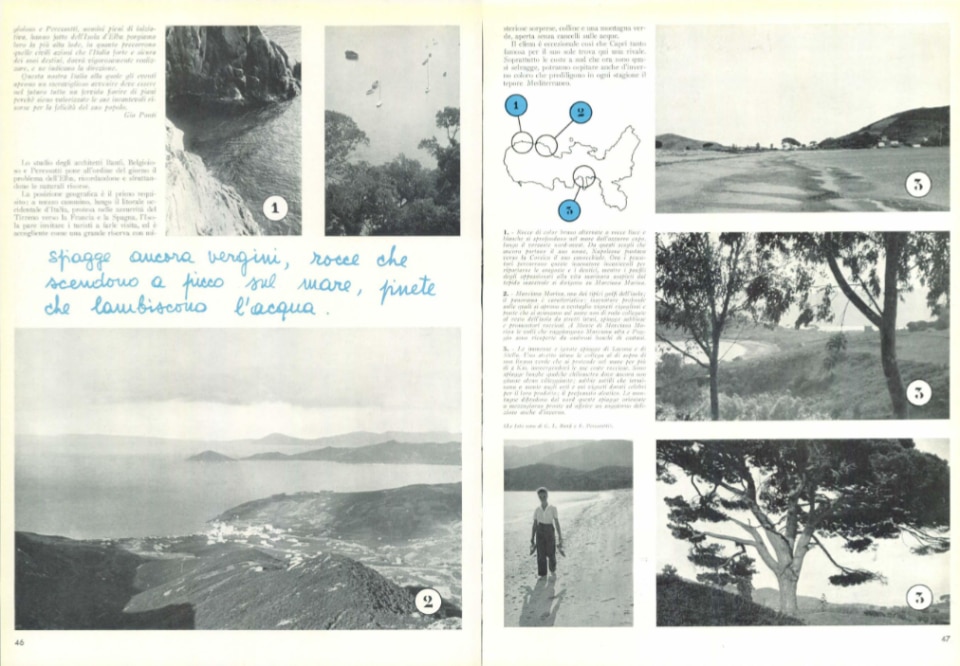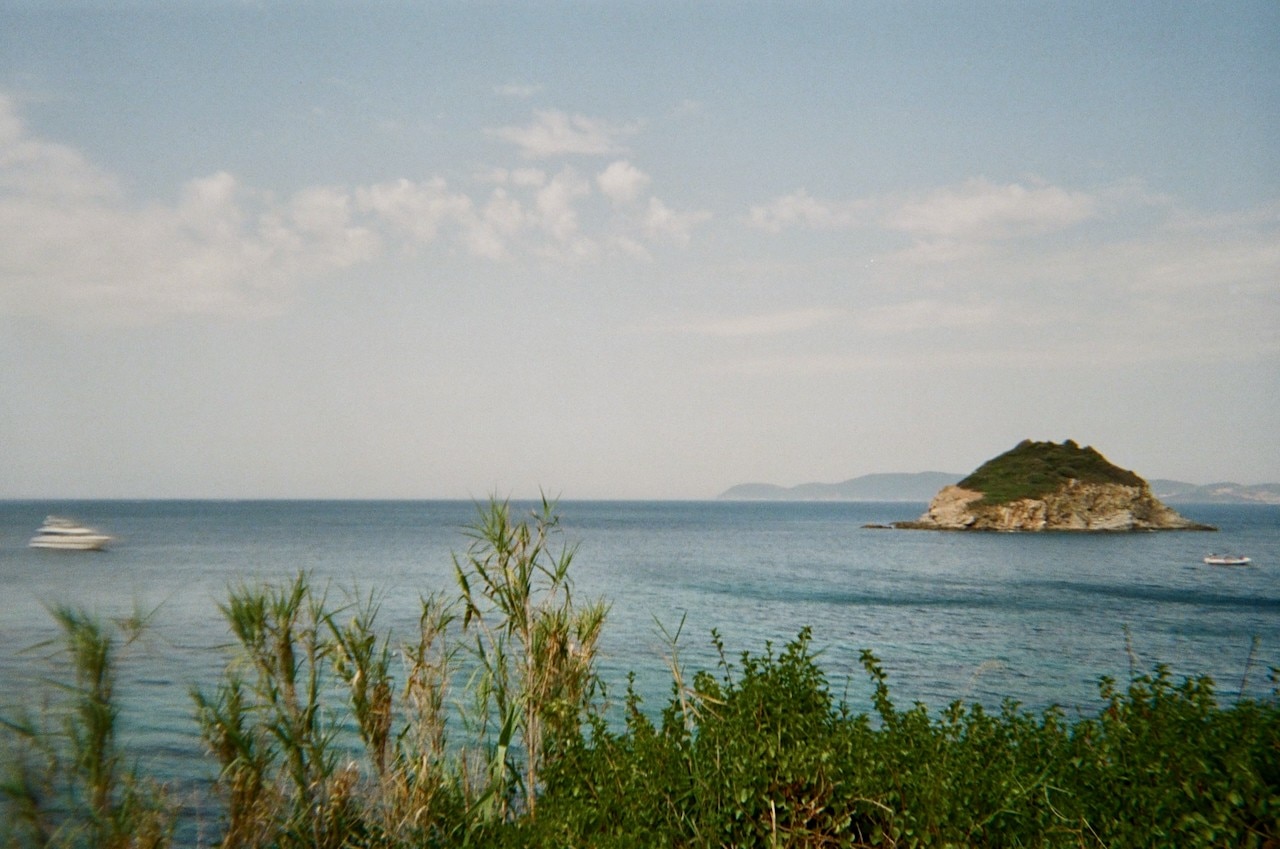"The climate is so exceptional that Capri, so famous for its sunshine, finds a rival here. Especially the coasts to the south, which are now almost wild, will be able to accommodate even in winter those who prefer Mediterranean warmth in every season”, wrote Gio Ponti with BBPR a few decades ago, showing some modernist faith in science, still probably aware, already, of one simple fact as well: that Elba is no Capri.
Since the early nineteenth century already, when the most healthy and wealthy scions of Europe had returned to swarm around the Faraglioni, engaged in the last seasons of the Grand Tour era – resumed after violent wartime pauses – Elba was instead assigned a single cumbersome tenant, the actual responsible for that pause, whom in reason of that cumbersomeness we will not name, at least for now.
Be it because of its productive nature – the mines, the metal industry, the crops – be it because of a perceptual component – those who have been frequenting the island for decades, though not born there, have spoken to us of a piece of Tuscany, rather than a Mediterranean island as it actually would be – the monumental metaphysical iron rock off the coast of Piombino actively resists any planned attempt to include it in any predatory mass tourist flow, or celebrity imaginary – jet set, as it would befit an archival article – or unattainable glittering paradise for the few. It is not Capri, but neither is it Punta Ala or Gallura. It is Elba.

Domus followed many of these attempts, and very closely.
In 1940 Gio Ponti presented a study by BBPR – with Rogers forced out of visibility by Italian racial laws – to enhance Elba as the tourist pearl of a future Italy (Domus 152, August 1940). Once realistically assessed the historical context of an Italy that still found itself officially indulging in a delirium of expansionist grandeur, as it was instead embarking on the final descent of its darkest two decades, going through the BBPR study reveals an intimately and enthusiastically modern research project, bristling with data and schemes: it actually deploys visual devices such as scale comparisons, collages and infographics – of fish, coastlines and rocks – that years later would meet a great fortune; It tells of a planned and plannable Elba where some new, rationalist settlements, such as the one at the Gulf of Biodola, find their place alongside strategy and infrastructure projects.

Still, Elba bears no trace of such plannability for mass usage. The stories that one can encounter there bear the mark of unsuspected uniqueness, as it happens with the Schiopparello, the catamaran leading to Piombino today, actually born and raised in its first 20 years in Connecticut. Or with the beach cabins that would inspire the quintessential metaphysical archetype of Italian design, the Cabina dell’Elba (Elba Cabin) conceived in 1980 by Aldo Rossi. No stories of loud celebrity it was said – never have we read about villas purchased by the Jenners or Kardashians of the day: it is more likely that the celebrities we are talking about spend their Elban days well entrenched in well-defiled villas, or at the bar of some marina, intent on playing table soccer.
This had already been the case with the villa that French couturier Pierre Balmain – while busy overturning the canons of fashion for the coming decade – had Leonardo Ricci design for him in 1959 (Domus 354, May 1959): the form is Martian yet organic, an exception that creates a formal and spatial dialogue, all its own so, with the island; in very poor words: something that fits.

It fits as also radical artist-architect Gianni Pettena would, about ten years later, with his minimal house, hidden in the woods, his first built architecture, made of an alchemy of materials that are poor and hyper-expressive at the same time: a work in which he involves friends – Sottsass, Marano, Branzi – making Franco Raggi speak of “measured modesty, within which signs and ideas regarding space, materials and use remain like glowing embers” (Domus 944, February 2011)
It is a matter of abiding by an unwritten law, of harmonizing with the nature of a place that – while surely carrying a different idea of life – states its intrinsic difference through its materiality. It is both the water of its coves and the pyrite of its mines, which the artist Giò Pomodoro would embed in his 1962 jewels (Domus 386, January 1962): could a place ever be better sublimated into an object?

Then came the 1960s, bringing a good amount of great returns. Gio Ponti, the Ponti of villas and crystals, who in Capo Perla realizes the Villa Ottagonale and the Villa Allungata, a couple of epitomes of his poetics as well as two off-scale jewels – object and landscape again are inextricably interlocked, as it happened with the other Giò, the one with the accent, the one of the jewels – already conceived as volumes all edges and not as facades – Marco Romanelli remarked – as an achievement in years of drawings full of hypothetical trajectories, on which the inhabitants move between narrative focuses, “castle of waters and lights”, “furnished window”, “river of grass”, “letti di muro” (masonry beds), “armchair with little seat” and, here, “openings on paradise”. (Domus 732, November 1991)
It is a matter of abiding by an unwritten law, of harmonizing with the nature of a place that – while surely carrying a different idea of life – states its intrinsic difference through its materiality.

BBPR as well would return, together with landscape designer Pietro Porcinai, to the idea of a tourist settlement (Domus 367, June 1960), and this time at Capo di Stella they would merge with the rocks, follow topography and rhythm, and conceive a matrix to be theoretically extended to infinity, which today leaves us with the hotel named after the place. A sense of dialogue pervades this return, and architectural form finally finds its place.
It might be more difficult, however, to find one for the colorful vibrapac concrete pillars and stripes that Roberto Gabetti and Aimaro Isola then deployed between the 1970s and late 1980s at the bottom of the Bagnaia plain with their Villa Sant'Anna complex (Domus 749, May 1993), but even there the island and the dialogue do their work, shaping a cascade of terraces out of them, as suspended and metaphysical as a mine on its work break.

After the various returns, at this point, one can then name the famous cumbersome tenant, who never returned instead: in terms of exile, Napoleon Bonaparte could have actually spared himself the Atlantic Ocean. By 1814, he had already found his St. Helena, so impervious to his encumbrance and domination (strained between a tyrannicidal Elban and Monica Bellucci, as in the film N. Io e Napoleone, by Paolo Virzì) in its unwritten law of physical and spiritual distance from the things of the world, even though it has gathered by now enough room and infrastructure to accommodate them every summer.
Cover picture: view from Frugoso beach, Cavo, isola d'Elba. Photo Gaia D'Angelo



















